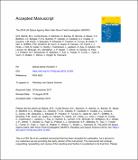The 2016 UK Space Agency Mars Utah Rover Field Investigation (MURFI)
Abstract
The 2016 Mars Utah Rover Field Investigation (MURFI) was a Mars rover field trial run by the UK Space Agency in association with the Canadian Space Agency's 2015/2016 Mars Sample Return Analogue Deployment mission. MURFI had over 50 participants from 15 different institutions around the UK and abroad. The objectives of MURFI were to develop experience and leadership within the UK in running future rover field trials; to prepare the UK planetary community for involvement in the European Space Agency/Roscosmos ExoMars 2020 rover mission; and to assess how ExoMars operations may differ from previous rover missions. Hence, the wider MURFI trial included a ten-day (or ten-‘sol’) ExoMars rover-like simulation. This comprised an operations team and control centre in the UK, and a rover platform in Utah, equipped with instruments to emulate the ExoMars rovers remote sensing and analytical suite. The operations team operated in ‘blind mode’, where the only available data came from the rover instruments, and daily tactical planning was performed under strict time constraints to simulate real communications windows. The designated science goal of the MURFI ExoMars rover-like simulation was to locate in-situ bedrock, at a site suitable for sub-surface core-sampling, in order to detect signs of ancient life. Prior to “landing”, the only information available to the operations team was Mars-equivalent satellite remote sensing data, which were used for both geologic and hazard (e.g., slopes, loose soil) characterisation of the area. During each sol of the mission, the operations team sent driving instructions and imaging/analysis targeting commands, which were then enacted by the field team and rover-controllers in Utah. During the ten-sol mission, the rover drove over 100 m and obtained hundreds of images and supporting observations, allowing the operations team to build up geologic hypotheses for the local area and select possible drilling locations. On sol 9, the team obtained a subsurface core sample that was then analyzed by the Raman spectrometer. Following the conclusion of the ExoMars-like component of MURFI, the operations and field team came together to evaluate the successes and failures of the mission, and discuss lessons learnt for ExoMars rover and future field trials. Key outcomes relevant to ExoMars rover included a key recognition of the importance of field trials for (i) understanding how to operate the ExoMars rover instruments as a suite, (ii) building an operations planning team that can work well together under strict time-limited pressure, (iii) developing new processes and workflows relevant to the ExoMars rover, (iv) understanding the limits and benefits of satellite mapping and (v) practicing efficient geological interpretation of outcrops and landscapes from rover-based data, by comparing the outcomes of the simulated mission with post-trial, in-situ field observations. In addition, MURFI was perceived by all who participated as a vital learning experience, especially for early and mid-career members of the team, and also demonstrated the UK capability of implementing a large rover field trial. The lessons learnt from MURFI are therefore relevant both to ExoMars rover, and to future rover field trials.
Citation
Balme , M R , Curtis-Rouse , M C , Banham , S , Barnes , D , Barnes , R , Bauer , A , Bedford , C C , Bridges , J C , Butcher , F E G , Caballo-Perucha , P , Caldwell , A , Coates , A J , Cousins , C , Davis , J M , Dequaire , J , Edwards , P , Fawdon , P , Furuya , K , Gadd , M , Get , P , Griffiths , A , Grindrod , P M , Gunn , M , Gupta , S , Hansen , R , Harris , J K , Hicks , L J , Holt , J , Huber , B , Huntly , C , Hutchinson , I , Jackson , L , Kay , S , Kyberd , S , Lerman , H N , McHugh , M , McMahon , W J , Muller , J-P , Ortner , T , Osinski , G , Paar , G , Preston , L J , Schwenzer , S P , Stabbins , R , Tao , Y , Traxler , C , Turner , S , Tyler , L , Venn , S , Walker , H , Wilcox , T , Wright , J & Yeomans , B 2018 , ' The 2016 UK Space Agency Mars Utah Rover Field Investigation (MURFI) ' , Planetary and Space Science , vol. In press . https://doi.org/10.1016/j.pss.2018.12.003
Publication
Planetary and Space Science
Status
Peer reviewed
ISSN
0032-0633Type
Journal article
Description
MURFI was financially supported in part by the UK Space Agency, and by the following grants: Balme: UK SA grants ST/L00643X/1 and ST/R001413/1; Bridges: UK SA grant ST/R00143X/1; Butcher and Wright: STFC studentship grant ST/N50421X/1; Coates and Griffiths: UK SA grant ST/R002223/1; Cousins: Royal Society of Edinburgh Research Fellowship and UK SA grant ST/P001297/1; Davis: UK STFC grant ST/K502388/1; Grindrod: UK SA and STFC grants ST/J005215/1, ST/L006456/1, ST/N000528/1; Gunn: UK SA grants ST/P001408/1, ST/P001394/1, ST/N006410/1; Muller: UK SA grant ST/P002145/1; Preston: UK SA grant ST/P001254/1; Stabbins: UK SA studentship grant ST/N002377/1. We thank the UK Harwell Campus Satellite Applications Catapult for providing access to the control room that became the MOC, and the STFC Rutherford Appleton Laboratory for other ROC support.Collections
Items in the St Andrews Research Repository are protected by copyright, with all rights reserved, unless otherwise indicated.

